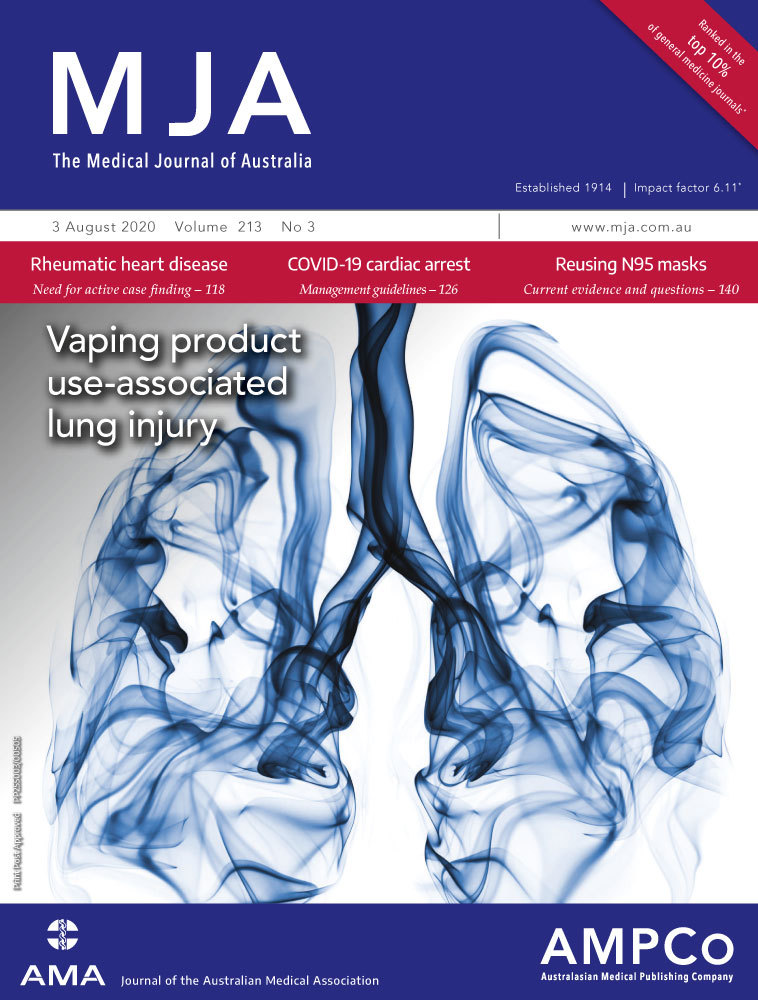Letters
Reusing N95 (or P2) masks: current evidence and urgent research questions
James M Branley,
Adam Polkinghorne,
Gwendolyn L Gilbert,
Corresponding Author
James M Branley
Nepean Hospital, Sydney, NSW
University of Sydney, Sydney, NSW
Search for more papers by this authorAdam Polkinghorne
Nepean Hospital, Sydney, NSW
University of Sydney, Sydney, NSW
Search for more papers by this authorGwendolyn L Gilbert
University of Sydney, Sydney, NSW
Marie Bashir Institute for Infectious Diseases and Biosecurity, University of Sydney, Sydney, NSW
Search for more papers by this authorJames M Branley,
Adam Polkinghorne,
Gwendolyn L Gilbert,
Corresponding Author
James M Branley
Nepean Hospital, Sydney, NSW
University of Sydney, Sydney, NSW
Search for more papers by this authorAdam Polkinghorne
Nepean Hospital, Sydney, NSW
University of Sydney, Sydney, NSW
Search for more papers by this authorGwendolyn L Gilbert
University of Sydney, Sydney, NSW
Marie Bashir Institute for Infectious Diseases and Biosecurity, University of Sydney, Sydney, NSW
Search for more papers by this authorThe unedited version of this article was published as a preprint on mja.com.au on 9 April 2020
No abstract is available for this article.
References
- 1 National Health and Medical Research Council. Australian guidelines for the prevention and control of infection in healthcare (2019). Canberra: NHMRC, 2019. https://nhmrc.govcms.gov.au/about-us/publications/australian-guidelines-prevention-and-control-infection-healthcare-2019 (viewed June 2020).
- 2Wang X, Pan Z, Cheng Z. Association between 2019-nCoV transmission and N95 respirator use. J Hosp Infect 2020; 105: 104–105.
- 3Fisher EM, Shaffer RE. Considerations for recommending extended use and limited reuse of filtering facepiece respirators in health care settings. J Occup Environ Hyg 2014; 11: D115–D128.
- 4Beckman S, Materna B, Goldmacher S, et al. Evaluation of respiratory protection programs and practices in California hospitals during the 2009–2010 H1N1 influenza pandemic. Am J Infect Control 2013; 41: 1024–1031.
- 5Mills D, Harnish DA, Lawrence C, et al. Ultraviolet germicidal irradiation of influenza-contaminated N95 filtering facepiece respirators. Am J Infect Control 2018; 46: e49–e55.
- 6Lindsley WG, Martin SB, Thewlis RE, et al. Effects of ultraviolet germicidal irradiation (UVGI) on N95 respirator filtration performance and structural integrity. J Occup Environ Hyg 2015; 12: 509–517.
- 7Lin TH, Chen CC, Huang SH, et al. Filter quality of electret masks in filtering 14.6–594 nm aerosol particles: effects of five decontamination methods. PLoS One 2017; 12: e0186217.
- 8Viscusi DJ, Bergman MS, Eimer BC, Shaffer RE. Evaluation of five decontamination methods for filtering facepiece respirators. Ann Occup Hyg 2009; 53: 815–827.
- 9Viscusi DJ, Bergman MS, Novak DA, et al. Impact of three biological decontamination methods on filtering facepiece respirator fit, odor, comfort, and donning ease. J Occup Environ Hyg 2011; 8: 426–436.
- 10Lore MB, Heimbuch BK, Brown TL, et al. Effectiveness of three decontamination treatments against influenza virus applied to filtering facepiece respirators. Ann Occup Hyg 2012; 56: 92–101.
- 11Carratalà A, Dionisio Calado A, Mattle MJ, et al. Solar disinfection of viruses in polyethylene terephthalate bottles. Appl Environ Microbiol 2016; 82: 279–288.
- 12Lin TH, Tang FC, Hung PC, et al. Relative survival of Bacillus subtilis spores loaded on filtering facepiece respirators after five decontamination methods. Indoor Air 2018; 28: 754–762.
- 13Coulliette AD, Perry KA, Fisher EM, et al. MS2 coliphage as a surrogate for 2009 pandemic influenza A (H1N1) virus (pH1N1) in surface survival studies on N95 filtering facepiece respirators. J Int Soc Respir Prot 2014; 21: 14–22.




